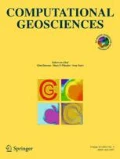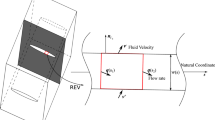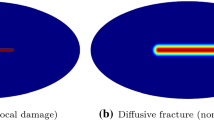Abstract
In the context of long-term degradation of porous media, the coupling between fracture mechanics and reactive transport is investigated. A reactive transport model in a cracked discontinuous and heterogeneous porous medium is proposed. The species transport through and along the crack network are taken into account in a multibody approach. A dedicated geochemistry solver is developed and allows to take into account a significant number of chemical reactions. The model is validated via a benchmark for a porous medium without discontinuity. The applications deal with two kinds of chemical attacks in a pre-cracked concrete sample and highlight the impact of the discontinuities in the reactive transport kinetic and on the localization of the chemical degradation. The results bring out that a unidirectional descriptor, such as the depth of ingress rate, is not sufficient to describe the material degradation correctly.
Similar content being viewed by others
References
Amir, L., Kern, M.: A newton–krylov method for coupling transport with chemistry in porous media
Archie, G.E.: The electrical resistivity log as an aid in determining some reservoir characteristics trans. AIME 146(01), 54–62 (1942)
Bergheau, J.-M., Leblond, J.-B.: Implémentation numérique et application de modèles de diffusion/réaction dans les solides. 14ème Colloque National en Calcul des Structures (2019)
Bichet, L.: Mécanisme de transport dans la fissuration des matériaux hétérogenes : application a la durée de vie d’éxploitation des centrales nucléaires. PhD thesis, Université de Montpellier II (2017)
Hilaire, A.: Etude des déformations différées des bétons en compression et en traction, du jeune au long terme : application aux enceintes de confinement. PhD thesis, Ecole Normale Supérieure de Cachan (2014)
Blanc, P. h., Lassin, A., Piantone, P., Azaroual, A., Jacquemet, N., Fabbri, A., Gaucher, E.C.: Thermoddem: A geochemical database focused on low temperature water/rock interactions and waste materials. Appl. Geochem. 27(10), 2107–2116 (2012)
Budiansky, B., OĆonnel, R. J.: Elastic moduli of a cracked solid. Int. J. Solids Struct. 12, 81–97 (1976)
Campos, A., López, C. M., Aguado, A.: Diffusion reaction model for the internal sulfate attack in concrete. Constr. Build. Mater. 102, 531–540 (2016)
Carrayrou, J., Hoffmann, J., Knabner, P., Kräutle, S., De Dieuleveult, J., Erhel, C., Van Der Lee, J., Lagneau, V., Mayer, K.U., MacQuarrie, K.T.B.: Comparison of numerical methods for simulating strongly nonlinear and heterogeneous reactive transport problems the MoMaS benchmark case. Comput. Geosci. 14, 483–502 (2010)
De Dieuleveult, C., Erhel, J., Kern, M.: A global strategy for solving reactive transport equations. J. Comput. Phys. 228, 6395–6410 (2009)
De Windt, L., Bradreddine, R., Lagneau, V.: Long-term reactive transport modelling of stabilized/solidified waste: from dynamic leaching tests to disposal scenarios. J. of Hazard. Mater. 139, 529–536 (2007)
Delaume, E.: Méthode de raffinement local adaptatif multiniveaux pour la fissuration des matériaux hétérogènes. PhD thesis, Université Montpellier II (2017)
Djerbi, A., Bonnet, S., Khelidj, A., Baroghel-Bouny, V.: Influence of traversing crack on chloride diffusion into concrete. Cem. Conc. Res. 38, 877–883 (2008)
Erhel, J., Sabit, S., De Dieuleveult, C.: Developments in parallel, distributed, grid and cloud computing for engineering. In: Topping, B.H.V., Iványi, P. (eds.) UK, Chapter 7: Solving Partial Differential Algebraic Equations and Reactive Transport Models, pp 151–169 (2013)
Erhel, J., Migot, T.: Characterizations of solutions in geochemistry: existence, uniqueness, and precipitation diagram. Comput. Geosci. 23, 523–535 (2019)
Haas, J., Nonat, A.: From csh to cash: Experimental study and thermodynamic modelling. Cem. Conc. Res. 68, 124–138 (2015)
Heukamp, F.H.: Chemomechanics of Calcium Leaching of Cement-Based Materials at Different Scales: The Role of CH-Dissolution and C-S-H-Degradation on Strength and Durability Performance of Materials and Structures. PhD thesis, Massachussetts Institute of Technology (2003)
Idiart, A.E., Bisschop, J., Caballero, A., Lura, P.: A numerical and experimental study of aggregate-induced shinkrage craking in cementitious composites. Cem. Conc. Res. 42, 272–281 (2012)
Idiart, A.E., López, C. M., Carol, I.: Chemo-mechanical analysis of concrete cracking and degradation due to external sulfate attack: A meso-scale model. Cem. Concr. Compos. 33, 411–423 (2011)
Jebli, M., Jamin, F., Garcia-Diaz, E., El Omari, M., El Youssoufi, M.S.: Influence of leaching on the local mechanical properties of an aggregate-cement paste composite. Cem. Concr. Compos. 73, 241–250 (2016)
Kchakech, B.: Etude de l’influence de l’échauffement subi par un béton sur le risque d’expansions associées à la Réaction Sulfatique Interne. PhD thesis, Université Paris-Est (2016)
Kondo, D., Dormieux, L.: Approche micromécanique du couplage perméabilité-endommagement. Compte Rendu Mecanique (2004)
Lagneau, V., Van Der Lee, J.: Hytec results of the momas reactive transport benchmark. Comput. Geosci. 14, 435–449 (2010)
Lagneau, V., Van Der Lee, J.: Operator-splitting-based reactive transport models in strong feedback of porosity change: The contribution of analytical solutions for accuracy validation and estimator improvement. J. Contam. Hydrol. 112, 118–129 (2010)
Leblond, J. B., Bergheau, J. M., Lacroix, R., Huin, D.: Implementation and application of some nonlinear models of diffusion/reaction in solids. Finite Elements in Anal. Des. 132, 8–26 (2017)
Liaudat, J.: Experimental and numerical study of the effect of stress on ASR expansions in concrete. PhD thesis, School of Civil Engineering of Barcelona (2018)
Lothenbach, B., Kulik, D., Matschei, T., Balonis, M., Baquerizo, L., Dilnesa, B.Z., Miron, D.G., Myers, R.: Cemdata18: A chemical thermodynamic database for hydrated portland cements and alkaliactivated materials. Cem. Conc. Res. 115, 472–506 (2019)
Marquié, C., Dauzeres, A., Richard, B., Nahas, G.: Concrete aging in containment building and deep geological disposal facilities: the ODOBA project. Transactions, SMiRT-25 Charlotte, NC, USA (2019)
Martin, R.P., Metalssi, O.O., Toutlemonde, F.: Importance of considering the coupling between transfer properties, alkali leaching and expansion in the modelling of concrete beams affected by internal swelling reactions. Constr. Build. Mater. 49, 23–30 (2013)
Mayer, K.U.: A Numerical Model for Multicomponent Reactive Transport in Variability Saturated Porous Media. PhD thesis, University of Waterloo (1999)
Mayer, K.U., Frind, E.O., Blowes, D.W.: Multicomponent reactive transport modeling in variably saturated porous media using a generalized formulation for kinetically controlled reactions. Water Resour. Res. 38(9), 1–21 (2002)
Mayer, K.U., MacQuarrie, K.T.B.: Solution of the MoMaS reactive transport benchmark with MIN3P—model formulation and simulation results. Comput. Geosci. 14, 405–419 (2010)
Michel, J.C., Suquet, P., Thébaud, F.: Une modélisation du rôle des interfaces dans le comportement des composites à matrice métallique. Revue Europé,enne des Éléments 3(4), 573–595 (1994)
Miura, T., Maruyama, I., Nakamura, H., Yammoto, Y.: Feedback system of ion transfer through cracks during deterioration of mortar due to sulfate attack evaluated by rbsm-truss network model. J. of Adv. Concr. Tech. 15, 610–626 (2017)
Morel, F., Morgan, J.: A numerical method for computing equilibria in aqueous chemical systems. Environ. Sci. Tech. 6(1), 58–67 (1972)
Nardi, A., Idiart, A., Trichero, P., Manuel, L., de Vries, L.M., Molinero, J.: Interface comsol-phreeqc (icp), an efficient numerical framework for the solution of coupled multiphysics and geochemistry. Computer Geosci. 69, 10–21 (2014)
Neji, M., Bary, B., Le Bescop, P., Burlion, N.: Swelling behavior of ion exchange resins incorporated in tri-calcium silicate cement matrix: I. chemical analysis. J. Nucl. Mater. 467, 544–556 (2015)
Nilenius, F., Larsson, F., Lundgren, K., Runesson, K.: Mesoscale modelling of crack-induced diffusivity in concrete. Comput. Mech. 55(2), 359–370 (2015)
Ochs, M., Mallants, D., Wang, L.: Radionuclide and Metal Sorption on Cement and Concrete. Chapter 2: Cementitious Materials and Their Sorption Properties. Springer International Publishing, Berlin (2016)
Oliveira, I., Cavalaro, H.P., Aguado, A.: New kinetic model to quantify the internal sulfate attack in concrete. Cem. Conc. Res. 43, 95–104 (2013)
Ollivier, J.P., Vichot, A.V., Capmas, A., Nonat, A., Torrenti, J.-M., Damidot, D., Le Bescop, P., Pons, G., Guérinet, M., Acker, P., Guiraud, P., Rougeau, P., Baroghel-Bouny, V., Cussigh, F., Laurens, S., Gagné, R., Capra, B., Linger, L., Carles-Gibergues, A., Honain, H., Escadeillas, G., Colina, H., Robert, F., Debicki, G., Fryda, H., Saucier, F., Lamberet, S., Scrivener, K., Guinot, D., Sommain, D.: La durabilité des bétons. Presses de l’Ecole Nationale des Ponts et Chaussées (2008)
Papachristos, E., Scholtès, L., Donzé, V., Chapeyre, B.: Intensity and volumetric characterizations of hydraulically driven fractures by hydro-mechanical simulations. Int. J. Rock Mech. Min. Sci. 93, 163–178 (2017)
Parkhurst, D.L., Wissmeier, L.: Phreeqcrm: A reaction module for transport simulators based on the geochemical model phreeqc. Adv. Water Resour. 8, 176–189 (2015)
Pelissou, C.: Discrétisation spatiotemporelle du problème thermique à deux champs : application au procédé de forgeage à chaud. PhD thesis, École Nationale Supérieure des Mines de Paris (2005)
Perales, F., Bourgeois, S., Chrysochoos, A., Monerie, Y.: Two field multibody method for periodic homogenization in fracture mechanics of non linear heterogeneous materials. Eng. Fracture Mech. 75, 3378–3398 (2008)
Perko, J., Ukrainczyk, N., Savija, B., Phung, Q.T., Koenders, E.A.B.: Influence of Micro-Pore Connectivity and Micro-Fractures on Calcium Leaching of Cement Pastes—A Coupled Simulation Approach Mat 13 (2697)
Perales, F., Dubois, F., Monerie, Y., Piar, B., Stainier, L.: A nonsmooth contact dynamics-based multi-domain solver. code coupling (xper) and application to fracture. Eu. J. Comput. Mech. 19(4), 389–417 (2010)
Perales, F., Dubois, F., Monerie, Y., Mozul, R., Babik, F.: Xper : une plateforme pour la simulation numérique distribuée d’interactions multiphysiques entre corps 14ème Colloque National en Calcul des Structures (2019)
J Perko, K.U., Mayer, G., Kosakowski, L., De Windt, J., Govaerts, D., Jacques, D. S. u., Meeussen, J.C.L.: Decalcification of cracked cement structure. Comput. Geosci. 19, 673–693 (2015)
Perko, J., Seetharam, S., Mallants, D.: Verification and validation of flow and transport in cracked saturated porous media. Excerpt from the Proceedings of the 2011 COMSOL Conference in Stuttgart (2011)
Planel, D., Sercombe, J., Le Bescop, P., Adenot, F., Torrenti, J. -M.: Long-term performance of cement paste during combined calcium leaching-suflate attack: kinetics and size effect. Cem. Conc. Res. 36, 137–143 (2006)
Poyet, S., Sellier, A., Capra, B., Foray, G., Torrenti, J. -M., Cognon, E., Bourdarot, E.: Chemical modelling of alkali silica reaction: Influence of the reactive aggregate size distribution. Mater. Struct. 40, 229–239 (2007)
Repina, M., Bouyer, F., Lagneau, V.: Reactive transport modeling of glass alteration in a fractured vitrified nuclear glass canister: From upscaling to experimental validation. J. Nucl. Mater. 528, 151869 (2020)
Salgues, M., Sellier, A., Multon, S., Bourdarot, E., Grimal, E.: DEF modelling based on thermodynamic equilibria and ionic transfers for structural analysis. Eur. J. Environ. Civ. Eng. 18(4), 1–26 (2014)
Samson, E., Marchand, J.: Modeling the transport of ions in unsaturated cement-based materials. Comput. Struct. 85, 1740–1756 (2007)
Savija, B., Pacheco, J., Schlangen, E.: Lattice modeling of chloride diffusion in sound and cracked concrete. Cem. Conc. Compos. 42, 30–40 (2013)
Segura, J.M., Carol, I.: On zero-thickness interface elements for diffusion problems. Int. J. Numer. Anal. Methods Geomech. 28(9), 947–62 (2004)
Sellier, A., Multon, S.: Chemical modelling of delayed ettringite formation for assessment of affected concrete structures. Cem. Conc. Res. 108, 72–86 (2018)
Socié, A.: Modélisation chimiomécanique de la fissuration de matériaux cimentaires : vieillissement et tenue des enceintes de confinement des centrales nucléaires. PhD thesis, Université de Montpellier (2019)
Steefel, C.I., Lasaga, A.C.: A coupled model for transport of multiple chemical species and kinetic precipitation/dissolution reactions with application to reactive flow in single phase hydrothermal systems. Am. J. Sci. 294, 529–592 (1994)
Stora, E., Bary, B., He, Q. -C., Deville, E., Montarnal, P.: Modelling and simulations of the chemo-mechanical behaviour of leached cement-based materials leaching process and induced loss of stiffness. Cem. Conc. Res. 39, 763–772 (2009)
Suquet, P.M.: CSIM Courses and lectures - No. 302. International center for mechanical sciences. Chapter “Discontinuities and Plasticity” in Non Smooth Mechanics and Applications (1988)
Van der Lee, J.: Thermodynamic and mathematical concepts of CHESS. Ecole Nationale Supérieure des Mines de Paris (2009)
Van Der Lee, J., De Windt, L., Lagneau, V., Goble, P.: Module-oriented modeling of reactive transport with HYTEC. Comput. Geosci. (2003)
Wu, T., Wrigger, P.: Multiscale diffusion-thermal-mechanical cohesive zone model for concrete. Computer Mech. 55, 999–1016 (2015)
Author information
Authors and Affiliations
Corresponding author
Ethics declarations
Conflict of Interests
The authors declare that they have no conflict of interest.
Additional information
Publisher’s note
Springer Nature remains neutral with regard to jurisdictional claims in published maps and institutional affiliations.
Appendices
Appendix 1: Mass action law for solid reaction
The law of mass action is rewritten with logarithmic unknowns in order to ensure the positivity of all concentrations.
The bijectivity of the exponential function induces:
Appendix 2: Jacobian terms of the geochemical numerical method
The chemical model reads (see Section 3):
The system is solved by a Newton-Raphson method. The Jacobian of this system is given by:
where the Jacobian matrix terms are:
with :
If the electroneutrality is imposed (26), the chemical system is overdetermined. As implemented in CHESS software [63], one mass conservation relations of the aqueous species is replaced by the electroneutrality equation. The associated Jacobian term is:
Rights and permissions
About this article
Cite this article
Socié, A., Dubois, F., Monerie, Y. et al. Multibody approach for reactive transport modeling in discontinuous-heterogeneous porous media. Comput Geosci 25, 1473–1491 (2021). https://doi.org/10.1007/s10596-021-10058-x
Received:
Accepted:
Published:
Issue Date:
DOI: https://doi.org/10.1007/s10596-021-10058-x




